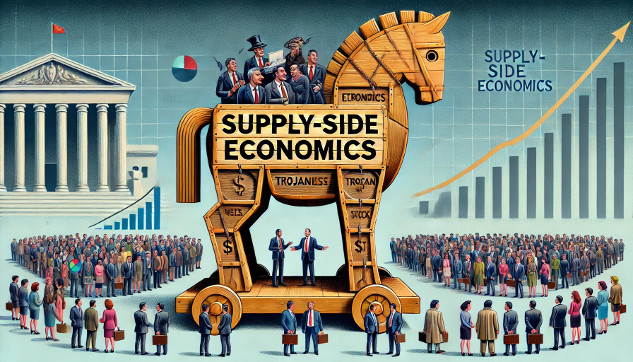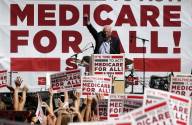
In this Article:
- What is Harris’s economic plan for 2024?
- How do the proposals address wealth inequality?
- What is the Two Santa Claus Theory, and how does it relate to today?
- How does Tim Walz’s record in Minnesota contribute to national reforms?
- Why do Harris and Walz’s bottom-up reforms contrast sharply with Trump’s approach?
Harris Economic Plan 2024: Empowering Middle-Class America
by Robert Jennings, InnerSelf.com
For decades, economic policy in the United States has swung between two competing visions: one that favors the wealthy and one that prioritizes the working class. At the heart of this debate lies the "Two Santa Claus Theory," introduced in the late 1970s by Republican strategist Jude Wanniski. His idea was simple: while Democrats acted as "Santa Claus" by offering social programs, Republicans could win voters by playing their own "Santa Claus" role through tax cuts. This strategy birthed the era of supply-side economics, which claimed that cutting taxes, especially for the wealthy, would stimulate growth and benefit everyone.
But history has shown us a different story. The promises of trickle-down economics have yet to materialize indeed. Instead, we've witnessed skyrocketing income inequality, a financial system inflated by speculation, and middle-class families struggling to keep up. As countries like Europe and the Nordic region adopted bottom-up economic policies that fostered widespread prosperity, the U.S. leaned into policies that concentrated wealth at the top.
Reflecting on these decades of economic experimentation, we realize that the stakes couldn't be higher. Recent efforts by the Biden administration have sought to correct this imbalance, offering hope for a more equitable future. With Vice President Harris and Governor Tim Walz now on the horizon, the question remains: will America choose a path of shared prosperity, or will it fall back into policies that serve the few at the expense of the many?
Origins of the Two Santa Claus Theory
In the late 1970s, political strategist Jude Wanniski introduced a concept that would forever reshape the Republican Party's approach to economic policy. Known as the "Two Santa Claus Theory," Wanniski's idea was born out of a need to compete with the Democrats, who had long been viewed as the party of social programs. In Wanniski's view, Democrats acted as a political "Santa Claus" by creating programs like Social Security, Medicare, and other public welfare initiatives that directly benefited the working class and low-income Americans. These programs won favor with voters, and Republicans struggled to counter this appeal without resorting to unpopular cuts in government spending. Wanniski believed the Republicans needed their own "Santa Claus" strategy and found it in tax cuts.
Wanniski's theory was simple: just as Democrats gained popularity by providing benefits through government spending, Republicans could position themselves as benefactors by offering tax cuts to the electorate. In his view, tax cuts, especially for businesses and the wealthy, would stimulate economic growth, boost productivity, and ultimately benefit everyone by increasing employment opportunities and wages. While Democrats increased government spending to fund their programs, Republicans would rely on economic expansion from tax reductions to offset revenue losses. This theory became the foundation of what is known today as supply-side economics. The idea was that a rising tide would lift all boats, and Republicans could reframe themselves as the party that supports individual prosperity through lower taxes rather than government handouts.
Wanniski developed this theory when the U.S. struggled with stagflation—an unusual combination of high inflation and unemployment. The American public was frustrated, and faith in the government's ability to manage the economy was waning. The political environment was ripe for a new economic approach, and Wanniski's theory provided a strategic shift. By casting tax cuts as a path to prosperity, Republicans could offer voters a tangible benefit while avoiding the political pitfalls of directly attacking popular social programs. This shift not only helped reshape public perception but also provided Republicans with a way to run up deficits and then blame Democrats for fiscal irresponsibility.
Republican Embrace of the Theory
Wanniski's "Two Santa Claus Theory" found its first major test during the Reagan administration. Elected in 1980, Ronald Reagan ran on a platform that promised to reduce taxes, shrink government, and strengthen the economy. His administration fully embraced supply-side economics, which argued that cutting taxes—particularly for the wealthy and corporations—would lead to more significant investment and job creation. This approach, known as Reaganomics, resulted in the Economic Recovery Tax Act of 1981, one of U.S. history's most critical tax cuts. Reagan believed he could unleash a wave of economic growth by significantly lowering income tax rates and reducing taxes on businesses.
However, the reality was far more complex. While the economy did grow during Reagan's presidency, the tax cuts also resulted in a substantial increase in the federal deficit. Rather than shrinking the size of government, Reagan simultaneously increased military spending, which compounded the problem. The deficits grew, but instead of acknowledging the role that tax cuts and defense spending played in this, Republicans blamed Democrats for the nation's fiscal woes, pointing to social spending as the culprit.
This blame-shifting became a central feature of the "Two Santa Claus Theory". Republicans could campaign on tax cuts, knowing that while deficits would rise in the short term, they could pin the financial instability on the spending programs introduced by Democrats. Meanwhile, the wealthy and corporations, the primary beneficiaries of these tax cuts, saw their fortunes rise. At the same time, the middle and working classes struggled to see the promised trickle-down benefits. Over time, this strategy deepened income inequality. It led to the growth of a speculative financial market. Still, the political framework set in motion by Wanniski and embraced by Reagan has persisted in Republican economic rhetoric ever since.
The Rise of Supply-Side Economics
With Ronald Reagan's election to the presidency in 1980, supply-side economics became the centerpiece of U.S. economic policy. Reagan's economic approach, dubbed "Reaganomics," was built on the belief that cutting taxes, especially for the wealthy and corporations, would stimulate economic growth and benefit all sectors of society. The core tenets of supply-side economics—tax cuts, deregulation, and increased defense spending—were all meant to work harmoniously to reduce government size while boosting private sector investment. Proponents of this model believed that lowering the tax burden on the wealthiest Americans would lead to job creation, wage increases, and broader economic prosperity as wealth "trickled down" to the lower and middle classes.
In practice, Reagan's policies were implemented through the Economic Recovery Tax Act of 1981, which slashed individual income tax rates and significantly reduced corporate taxes. Simultaneously, the Reagan administration rolled back numerous government regulations in industries ranging from finance to environmental protection to encourage business growth and innovation. At the same time, defense spending increased dramatically, driven by the Cold War arms race. However, despite promises of fiscal conservatism, the federal deficit ballooned as the combination of tax cuts and defense spending outpaced any potential economic growth.
David Stockman's Critique: The "Trojan Horse" Revelation
David Stockman, Reagan's Director of the Office of Management and Budget, played a crucial role in shaping and implementing the administration's economic policies. Initially a supporter of supply-side economics, Stockman became disillusioned with the theory's real-world consequences. In an infamous 1981 interview with "The Atlantic," Stockman revealed that supply-side economics was, in his view, a "Trojan horse" designed to justify tax cuts for the wealthy under the guise of stimulating economic growth. He criticized the policies as politically expedient but economically unsound, arguing that they disproportionately benefited the rich while doing little to help the middle class.
Stockman's critique exposed the central flaw of Reaganomics: while the economy did grow, the benefits accrued mainly to the wealthiest Americans. The promised "trickle-down" effects failed to materialize for most working- and middle-class citizens, and the tax cuts, combined with higher military spending, resulted in massive deficits. Despite these issues, the political appeal of tax cuts remained strong, and supply-side economics continued to shape Republican policy long after Reagan left office.
Thatcher and the Global Spread of Supply-Side Economics
The rise of supply-side economics was not confined to the United States. Across the Atlantic, British Prime Minister Margaret Thatcher adopted a similar approach from 1979 to 1990. Thatcher's economic philosophy, often called "Thatcherism," echoed the principles of Reaganomics, focusing on tax cuts, privatization of state-owned industries, and reducing the role of government in the economy. Like Reagan, Thatcher sought to stimulate economic growth by creating a business-friendly environment, believing free markets would naturally allocate resources more efficiently than government intervention.
The global spread of supply-side economics continued throughout the 1980s and 1990s, influencing economic policies in various Western countries, including Canada, Australia, and New Zealand. The model became a cornerstone of neoliberal economic thought, championed by institutions like the International Monetary Fund (IMF) and the World Bank, encouraging developing nations to adopt similar policies in exchange for financial assistance.
The Failure of Trickle-Down Economics
Despite its widespread adoption, supply-side economics has been criticized for failing to deliver its promises. From the Reagan era to the Trump administration, the idea that tax cuts for the wealthy would result in broad-based economic benefits has been consistently debunked. Instead of wealth "trickling down" to the middle and working classes, much flowed into financial markets and real estate, fueling speculative bubbles and exacerbating inequality.
One clear example is the growth of wealth and income inequality in the U.S. post-1980. According to numerous studies, the share of wealth held by the top 1% of Americans has steadily increased. At the same time, wages for the average worker have remained stagnant. Much of the wealth generated during the Reagan and subsequent Republican administrations flowed into non-productive assets like stocks, bonds, and real estate, inflating asset prices and creating bubbles in sectors such as housing and technology.
The 2008 financial crisis was a direct result of these speculative market dynamics, where deregulation and unchecked investment practices, many stemming from supply-side principles, led to the collapse of financial institutions. More recently, during the Trump administration, the 2017 Tax Cuts and Jobs Act once again reduced taxes on corporations and the wealthy. Still, the promised economic boom failed to benefit most Americans. Instead, corporations used their tax windfalls for stock buybacks and increased executive compensation while income inequality widened further.
The trickle-down economics' failure lies in its inability to create broad-based prosperity. Rather than lifting all boats, supply-side economics has concentrated wealth at the top, leaving the middle class and working poor increasingly marginalized in a speculative and unequal economy.
The Impact of Supply-Side Economics on Wealth Inequality
Supply-side economics has profoundly shaped the U.S. economy since its inception in the 1980s under Reagan. Its primary premise—that tax cuts, particularly for corporations and the wealthy, would stimulate economic growth—has failed to deliver widespread prosperity and significantly contributed to rising income inequality, national debt, and economic instability. Over time, this economic philosophy has deepened the divide between the wealthy and the working class while fostering financial speculation rather than productive investments in the real economy.
Exploding Deficits and National Debt
One of the most significant consequences of supply-side economics has been its impact on the national deficit and debt. The theory promised tax cuts would spur sufficient economic growth to offset revenue losses. However, tax cuts repeatedly failed to generate the necessary growth, leaving the government with large deficits. Under Reagan, deficits soared as tax revenues dropped while military spending surged. This pattern would repeat under subsequent Republican administrations.
Under George W. Bush, two rounds of tax cuts in 2001 and 2003—aimed primarily at high-income earners and corporations—again failed to stimulate the broad-based growth promised by supply-side advocates. Coupled with the costs of the wars in Iraq and Afghanistan, which were primarily funded off-budget, these policies led to a significant increase in the national debt. The deficit reached new highs by the end of Bush's presidency, leaving the incoming Obama administration to deal with the fallout during the financial crisis.
The Trump administration, in 2017, passed the Tax Cuts and Jobs Act, a hallmark of supply-side economics. The law lowered the corporate tax rate from 35% to 21%. It reduced individual tax rates across most brackets, with the wealthiest Americans and corporations benefiting the most. Once again, the cuts were justified by the promise of economic growth. However, while the stock market surged, wages remained stagnant, and income inequality worsened. The Congressional Budget Office (CBO) projected that these tax cuts would add $1.9 trillion to the national debt over the next decade, exacerbating fiscal instability without delivering significant benefits to the middle class or working poor.
Income Inequality and Financialization
At the heart of the failure of supply-side economics is the flow of wealth into financial markets and real estate rather than into productive investments. Instead of investing in infrastructure, technology, or industries that create jobs and enhance productivity, corporations, and wealthy individuals often use their tax savings for stock buybacks, dividend payments, and real estate investments. This process, known as "financialization," refers to the increasing dominance of financial markets and speculation over traditional, productive economic activities.
As a result, the wealthiest Americans, who are more likely to own stocks and real estate, have seen their fortunes grow exponentially. At the same time, wage growth for the average worker has remained stagnant. This dynamic has inflated the value of financial assets, creating bubbles similar to historical speculative frenzies like the tulip mania of the 17th century. Just as the prices of tulip bulbs soared beyond their intrinsic value, modern financial markets and real estate prices have often become detached from the real economy, driven more by speculation than underlying productivity.
The 2008 financial crisis was a stark example of the dangers of financialization. Fueled by speculative lending and investment practices, the housing market collapsed, triggering a global recession. In the years following the crisis, while financial markets recovered, the middle class and working poor were left behind, with homeownership rates declining and wage growth stagnating. This pattern continued under Trump, where tax cuts primarily enriched corporations and the wealthy, leading to further asset inflation and financial speculation.
Long-Term Consequences
The long-term consequences of supply-side economics have devastated fiscal stability and social equity. The national debt continues to rise, driven by repeated tax cuts that fail to produce the promised growth. Meanwhile, income inequality has reached levels not seen since the Gilded Age, as the wealthiest Americans accumulate more wealth. At the same time, the middle class struggles to maintain its economic standing.
Beyond the economic instability caused by rising debt and inequality, the social consequences are profound. As wealth becomes increasingly concentrated in the hands of a few, the middle class shrinks, and social mobility declines. Economic insecurity and financial instability have led to political polarization, as many Americans lose faith in the government's ability to manage the economy fairly and effectively.
In sum, supply-side economics still needs to deliver on its promises of widespread prosperity and exacerbate the problems it sought to solve. Prioritizing tax cuts for the wealthy and allowing wealth to flow into speculative financial markets has created an economy marked by rising inequality, fiscal instability, and growing social unrest.
How the Two Santa Claus Theory Shields Supply-Side Failures
The "Two Santa Claus Theory," as devised by Jude Wanniski, has not only shaped Republican economic policy but has also become a powerful tool for political manipulation. A vital aspect of this strategy lies in the "lag in economic policy effects"—the time it takes for the full impact of economic policies to become apparent. This delay has allowed Republicans to claim credit for positive financial outcomes that stem from Democratic policies while deflecting blame for negative consequences caused by their supply-side economics. This manipulation of public perception has sustained the belief in supply-side economics despite its repeated failures.
Log in Economic Policy Effects
Economic policies, especially those involving large-scale fiscal changes, often take years to manifest their effects fully. This delay can obscure the origins of financial successes and failures, allowing the party in power to take credit for positive developments that the previous administration may have set in motion. For Republicans, this has often meant benefiting from the economic stability and growth initiated by Democrats, only to turn around and promote supply-side tax cuts that ultimately lead to deficits and income inequality.
For example, under Bill Clinton's presidency in the 1990s, the U.S. economy saw significant growth and prosperity. Clinton's policies, which included raising taxes on the wealthy and reducing the deficit, helped balance the budget and create a surplus. However, when George W. Bush took office in 2001, he implemented massive tax cuts that primarily benefited the wealthy and reversed the fiscal discipline of the Clinton years. Initially, the economy continued to grow, mainly due to the momentum built up during the previous administration. Over time, however, the effects of Bush's tax cuts, along with the costs of wars in Iraq and Afghanistan, led to a ballooning deficit and a weakened economy that collapsed during the 2008 financial crisis.
This cycle played out again more recently during the Obama and Trump administrations. Barack Obama inherited an economy in freefall due to the 2008 financial crisis. His administration implemented stimulus packages, monetary reforms, and healthcare expansion, which helped stabilize the economy. However, economic recovery took time, and it wasn't until later in Obama's second term that the full effects of his policies became apparent. By the time Donald Trump took office in 2017, he had already inherited an economy that was on an upward trajectory. Yet, Trump claimed credit for the ongoing economic growth while implementing tax cuts, which eventually led to increased deficits and further income inequality.
A Different Version of the Two Santa Claus Theory
In addition to benefiting from the lag in economic policy effects, Republicans have also mastered the art of blaming Democrats for deficits and financial challenges that stem from their policies. This manipulation is a different version of the "Two Santa Claus Theory", where Republicans are seen as fiscal saviors through tax cuts. However, the long-term negative consequences of these policies—such as rising deficits and wealth inequality—are conveniently blamed on Democratic spending programs.
For example, under Reagan, massive tax cuts were implemented alongside increased military spending. While these policies led to short-term growth, they also resulted in significant deficits that burdened future administrations. Reagan's economic policies were celebrated as successes at the time. Still, the blame for the rising national debt was later shifted onto Democratic administrations, which were forced to manage the fiscal consequences. The same pattern occurred under George W. Bush and Donald Trump. Both presidents enacted tax cuts that benefited the wealthy, leading to rising deficits. Yet, when Democrats returned to power, they were accused of fiscal irresponsibility due to the inherited deficits and debt.
This cycle of Republicans enacting tax cuts, blaming Democrats for the resulting deficits, and then campaigning on further tax cuts has perpetuated public confusion about the true origins of economic challenges. As a result, voters are often misled into supporting policies that ultimately harm their financial interests. The ongoing success of this strategy underscores the political power of the "Two Santa Claus Theory," even in the face of mounting evidence that supply-side economics fails to deliver broad-based prosperity.
The Alternative: Bottom-Up Economics
While supply-side economics has been the dominant economic model in the U.S. since the 1980s, it is not the only approach to monetary policy. An alternative that has proven effective in creating broad-based prosperity is "bottom-up economics", which focuses on empowering the working and middle classes through social programs, labor rights, and public investments. This approach, pioneered by Franklin D. Roosevelt's New Deal, was responsible for lifting the U.S. out of the Great Depression and laying the foundation for the country's post-World War II economic boom. Today, many European and Nordic countries have adopted bottom-up policies, leading to sustainable economic growth, reduced inequality, and a robust social safety net.
FDR's New Deal and Its Success
In the wake of the Great Depression, Franklin D. Roosevelt's administration introduced the New Deal, a series of programs, public works projects, financial reforms, and regulations aimed at rescuing the U.S. economy and relieving millions of struggling Americans. FDR's New Deal epitomized bottom-up economics, focusing on creating opportunities for the working class rather than enriching the already wealthy.
One of the central pillars of the New Deal was the creation of "social programs" that provided immediate relief to those most affected by the Depression. Programs like Social Security, unemployment insurance, and the Works Progress Administration (WPA) helped stabilize the economy by providing income support to those in need and creating jobs for the unemployed. These initiatives alleviated poverty and helped build the infrastructure—such as roads, schools, and hospitals—that would fuel long-term economic growth.
Additionally, the New Deal supported "labor rights," creating the National Labor Relations Act, which protected workers' rights to organize and bargain collectively. This strengthened the position of labor unions, resulting in better wages, improved working conditions, and greater economic mobility for millions of Americans. As wages increased, so did consumer spending, further stimulating the economy and driving the post-war boom that built a thriving middle class.
FDR's bottom-up approach laid the foundation for decades of broad-based prosperity. The New Deal spurred economic mobility and expanded the middle class by prioritizing investments in infrastructure, social programs, and labor rights. This period of monetary stability and shared prosperity starkly contrasts the outcomes of supply-side economics, which has concentrated wealth at the top and undermined the financial security of ordinary workers.
European and Nordic Models
Many European and Nordic countries embraced similar bottom-up policies, achieving economic growth and social equity. These countries adopted a model that reduces inequality through strong "social safety nets," universal healthcare, high-quality education, and robust labor rights. These programs provide a foundation for individuals to succeed and contribute to a sustainable economy.
In countries like Sweden, Norway, Denmark, and Finland, "universal healthcare" ensures all citizens have access to quality medical care regardless of income. This relieves financial pressure on households, allowing them to invest in other areas of life, such as education or homeownership. Similarly, free or heavily subsidized "education" systems provide equal opportunities for citizens to pursue higher education, improving social mobility and creating a highly skilled workforce.
Another critical element of the Nordic model is vital "labor rights" and wage agreements. These countries have maintained high levels of unionization, ensuring that workers receive fair wages and enjoy protections that prevent exploitation. By negotiating fair wages and working conditions, Nordic countries have maintained a high standard of living for their workers, which, in turn, fuels consumer demand and sustains economic growth.
The European approach also prioritizes comprehensive "social safety nets", which include unemployment benefits, pensions, and family support programs. These safety nets reduce the risk of poverty, promote economic security, and help individuals recover from financial setbacks more quickly. As a result, European and Nordic countries enjoy low levels of income inequality and higher levels of social trust, contributing to social and political stability.
Sustainable Growth and Equality
The success of bottom-up economics in Europe and the Nordic countries demonstrates that economic growth and social equity are not mutually exclusive. By investing in the well-being of their citizens, these countries have created resilient, innovative, and equitable economies. Unlike supply-side economics, which concentrates wealth at the top and relies on speculative financial markets, bottom-up economics fosters a balanced, sustainable approach that benefits society.
Biden's Policies: A Return to Bottom-Up Economics
President Joe Biden's administration marks a significant departure from the supply-side economic policies that have dominated U.S. fiscal policy for decades. In a return to the principles of bottom-up economics, Biden's policies aim to address wealth inequality, rebuild the middle class, and invest in public goods that benefit the broader population. His approach is a direct response to the failures of supply-side economics, which have led to rising inequality and financial instability. Biden's economic agenda, which includes stimulus packages, child tax credits, and infrastructure investments, focuses on creating opportunities for the middle class and working families, echoing the reforms of Franklin D. Roosevelt's New Deal.
Biden's Economic Policies
Biden's administration has introduced several key initiatives designed to address systemic inequality and provide support to working Americans. Early in his presidency, Biden signed the American Rescue Plan Act of 2021, a $1.9 trillion economic stimulus package aimed at helping Americans recover from the financial impact of the COVID-19 pandemic. This plan included direct payments to individuals, extended unemployment benefits, and increased funding for small businesses, all providing immediate relief to those hit hardest by the pandemic.
One of the most significant features of Biden's policies is the Child Tax Credit expansion, designed to lift millions of children out of poverty. Under the plan, most families received monthly payments of up to $300 per child, providing essential financial support to working—and middle-class families. Studies have shown that this initiative alone reduced child poverty in the U.S. by nearly 30%, a significant step toward reducing wealth inequality and improving social mobility.
Additionally, Biden has focused heavily on infrastructure investment by passing the $1.2 trillion Infrastructure Investment and Jobs Act in 2021. This bill allocates funding to modernize transportation systems, expand broadband access, improve water systems, and rebuild bridges and roads across the country. Unlike supply-side economics, which often directs benefits to the wealthiest Americans, Biden's infrastructure plan is designed to create jobs, spur local economies, and improve the quality of life for everyday Americans.
Biden's policies also emphasize green energy investments to address economic inequality and climate change. Investment in renewable energy industries, such as wind and solar power, aims to create new jobs while transitioning the country from relying on fossil fuels. By prioritizing these industries, Biden seeks to build a sustainable economy that works for both the environment and the working class.
Correcting Supply-Side Failures
Biden's economic policies are a direct attempt to correct the damage done by decades of supply-side economics, which primarily benefited the wealthy and contributed to rising inequality. While previous Republican administrations promised that tax cuts for the rich would "trickle down" to the rest of society, Biden's policies aim to reverse this trend by directly supporting the middle class and working families. His administration's focus on direct relief—through stimulus payments, tax credits, and social programs—marks a clear shift away from the belief that cutting taxes for the wealthy leads to broad-based prosperity.
Biden's emphasis on "job creation" and "public investment" parallels FDR's New Deal. Just as Roosevelt's policies helped lift the U.S. out of the Great Depression by providing jobs and social security to millions, Biden's policies are designed to rebuild the middle class and reduce the economic disparities that have worsened since the Reagan era. By investing in infrastructure, education, and healthcare, Biden hopes to create the foundation for long-term economic growth, similar to the lasting impact of the New Deal.
One of Biden's most important contributions has been his focus on rebuilding trust in the government's ability to deliver for the people. Decades of supply-side economics led many Americans to believe that government intervention in the economy was ineffective or unnecessary. However, Biden's policies aim to show that the government can promote economic security and social equality by investing in the public good.
Rebuilding a Stronger Middle Class
Ultimately, Biden's policies represent a return to "bottom-up economics", where the focus is on lifting up the working and middle classes to create a more equitable and sustainable economy. By correcting the imbalances caused by supply-side policies, which favored the wealthy at the expense of the majority, Biden aims to restore the promise of the American Dream—a society where everyone has the opportunity to succeed, not just the few at the top. In this way, Biden's economic vision builds on the legacy of FDR, offering a pathway to rebuild a stronger, more inclusive middle class.
Trump's Economic Platform and Project 2025
Project 2025 is Trump's ambitious plan to dramatically reduce government regulation and expand executive control. This blueprint proposes scaling back environmental protections, rolling back labor rights, and curbing regulatory oversight across various sectors, aiming to boost economic growth by giving businesses more freedom.
Trump's proposed tariffs on imported goods are vital to his economic strategy. These tariffs encourage domestic production by making imported goods more expensive. However, the broad nature of these tariffs could have significant inflationary consequences. By raising the prices of essential goods like food, gas, and clothing, this "Trump tax" would effectively increase the cost of living for American families.
Potential Inflationary Impact and Economic Risks
The imposition of tariffs on a wide range of imports would likely trigger higher prices for everyday necessities, disproportionately affecting middle- and working-class households. The added costs of consumer goods could lead to inflationary pressures, raising concerns about economic instability. In particular, industries that rely on imported materials, such as manufacturing and retail, would face increased production costs, further driving up consumer prices. Economists argue that these tariffs could act as a regressive tax on the most vulnerable, complicating the economic recovery.
Threats to Democracy
Trump's approach to governance raises concerns about the erosion of democratic norms. His previous attempts to challenge the results of the 2020 election, coupled with efforts to consolidate executive power, signal a broader threat to the country's democratic institutions.
Many mainstream Republicans have reservations about Trump's impact on the rule of law and political stability. His disregard for constitutional norms has sparked fears that another term could weaken checks and balances, undermining the separation of powers. Further, Trump's influence over the judiciary and use of executive orders to bypass legislative processes reflect an alarming shift toward authoritarian governance.
The political landscape could see further polarization under another Trump presidency. His divisive rhetoric and policies have already deepened societal divisions, and a second term could exacerbate this trend. The risks extend beyond domestic politics to international relations. Trump's foreign policies, particularly his withdrawal from global alliances and trade deals, have damaged the U.S.'s standing on the world stage. The broader implications for democracy and international stability are profound, as Trump's leadership style moves the country away from democratic norms and institutions.
The Political Landscape: Harris, Walz, and Bottom-Up Economics
Vice President Kamala Harris's economic plan seeks to reduce the cost of living for working families through targeted measures. One of her key initiatives is to impose fines on companies engaged in price gouging for essential items like groceries. This policy aims to curb exploitative corporate behavior during inflation, ensuring that everyday goods remain affordable.
Harris also plans to introduce a $25,000 credit for first-time home buyers to make homeownership more accessible, especially for young families and those struggling with rising housing costs. This initiative is part of a broader effort to tackle housing affordability, a persistent challenge for many Americans.
Another critical element of Harris's platform is the expansion of the Child Tax Credit. Under her proposal, families with newborns would be eligible for up to $6,000 per year, providing vital financial support during a critical period in a child's development. The expanded credit is expected to reduce child poverty rates and provide relief for working families, continuing the work begun during the Biden administration with similar measures that significantly impacted poverty reduction.
Tim Walz's FDR-Style Reforms
Governor Tim Walz of Minnesota, Harris's running mate, brings a proven track record of bottom-up economic reforms that mirror the principles of FDR's New Deal. Under Walz's leadership, Minnesota has seen an expansion of affordable healthcare access, ensuring that more citizens can receive the medical care they need without facing financial hardship. His administration has also prioritized investments in infrastructure, creating jobs and stimulating economic growth by improving transportation, water systems, and broadband access. These investments boost the economy and help build a foundation for long-term prosperity.
Walz has also championed public education, increasing school funding and promoting policies supporting teachers and students. His administration has worked to enhance economic mobility through social safety nets that assist needy families, ensuring Minnesota's most vulnerable populations have the necessary resources to succeed.
National Potential
The success of Walz's reforms in Minnesota demonstrates the potential for these bottom-up policies to be scaled nationally. Expanding access to healthcare, investing in infrastructure, and supporting public education could address many structural issues contributing to inequality across the U.S. By empowering the middle class and reducing the wealth gap, these policies offer a sustainable alternative to the wealth-concentrating measures of supply-side economics.
Contrast to Supply-Side Economics
Harris and Walz's bottom-up economic approach contrasts sharply with Trump's supply-side economics, which prioritizes tax cuts for the wealthy and corporations. While Trump's policies rely on the trickle-down effect—assuming benefits will eventually reach the broader population—Harris and Walz focus on directly empowering middle—and working-class families through targeted investments and social programs. This approach can create more sustainable, equitable growth by building a solid middle class and reducing economic disparities.
The economic choices facing the U.S. today are stark. On one side stands "supply-side economics", which has dominated Republican policy for decades, promising prosperity through tax cuts for the wealthy and deregulation. However, history shows these policies have led to growing deficits, income inequality, and an economy driven by financial speculation rather than broad-based growth. On the other side is "bottom-up economics," a model rooted in FDR's New Deal that emphasizes investment in the middle class, social programs, and public goods to create sustainable, long-term economic stability and equity. The contrast between these two approaches could not be more apparent.
As the 2024 election approaches, voters face a critical decision. "Harris and Walz" represent an opportunity to continue building on Biden's policies that address wealth inequality and restore the middle class through bottom-up economic reforms. Their platform is focused on creating jobs, expanding healthcare, and investing in infrastructure—measures that aim to lift working families and ensure a fairer, more equitable economy. In contrast, "Trump's return" to office would likely bring a renewed focus on supply-side economics, which poses severe risks to the economy and the foundations of democracy itself. His previous term demonstrated how policies benefiting the few at the expense of the many could exacerbate inequality and undermine trust in democratic institutions.
Now more than ever, understanding the stakes of economic policy is essential. Voters must recognize these choices' long-term impact on "inequality, democracy, and the future of the middle class." The time has come to demand policies prioritizing the collective good over short-term gains for the wealthy. The future of the American economy—and its democracy—depends on it.
Article Recap:
This article explores the Harris Economic Plan 2024 and how it builds on the Two Santa Claus Theory and bottom-up economics. Harris and Walz propose a middle-class-focused strategy focusing on wealth inequality, child tax credits, first-time homebuyer incentives, and reforms modeled after FDR’s New Deal. Their plan contrasts sharply with supply-side economics, offering solutions that address long-standing disparities and inflationary risks.
About the Author
 Robert Jennings is co-publisher of InnerSelf.com with his wife Marie T Russell. He attended the University of Florida, Southern Technical Institute, and the University of Central Florida with studies in real estate, urban development, finance, architectural engineering, and elementary education. He was a member of the US Marine Corps and The US Army having commanded a field artillery battery in Germany. He worked in real estate finance, construction and development for 25 years before starting InnerSelf.com in 1996.
Robert Jennings is co-publisher of InnerSelf.com with his wife Marie T Russell. He attended the University of Florida, Southern Technical Institute, and the University of Central Florida with studies in real estate, urban development, finance, architectural engineering, and elementary education. He was a member of the US Marine Corps and The US Army having commanded a field artillery battery in Germany. He worked in real estate finance, construction and development for 25 years before starting InnerSelf.com in 1996.
InnerSelf is dedicated to sharing information that allows people to make educated and insightful choices in their personal life, for the good of the commons, and for the well-being of the planet. InnerSelf Magazine is in its 30+year of publication in either print (1984-1995) or online as InnerSelf.com. Please support our work.
Creative Commons 4.0
This article is licensed under a Creative Commons Attribution-Share Alike 4.0 License. Attribute the author Robert Jennings, InnerSelf.com. Link back to the article This article originally appeared on InnerSelf.com













